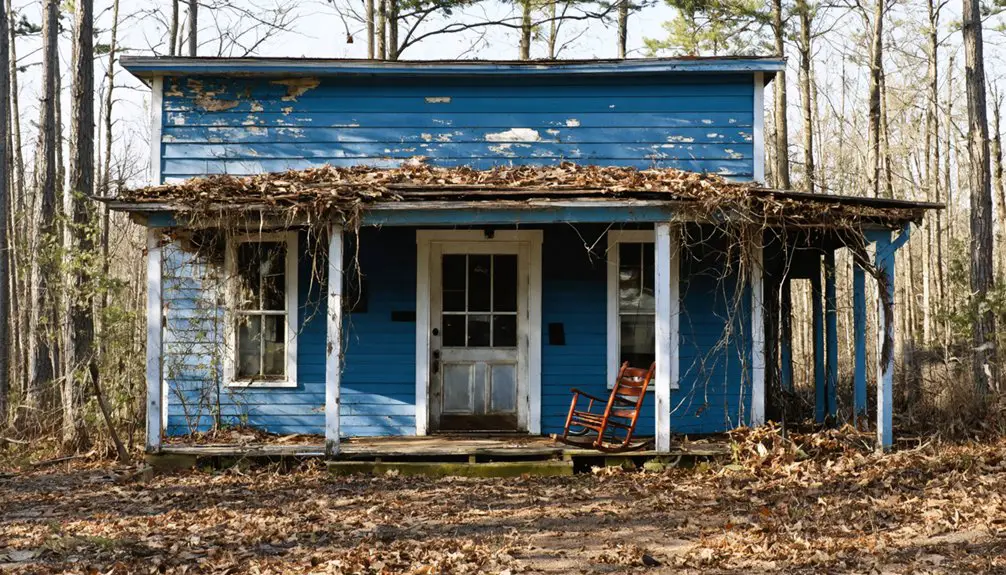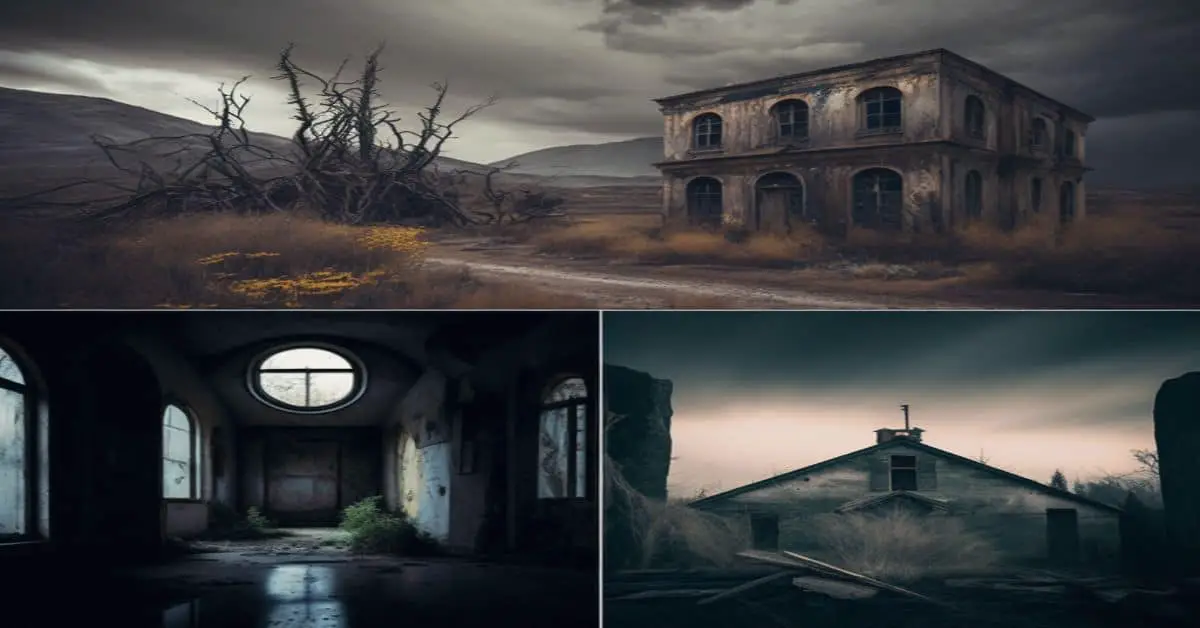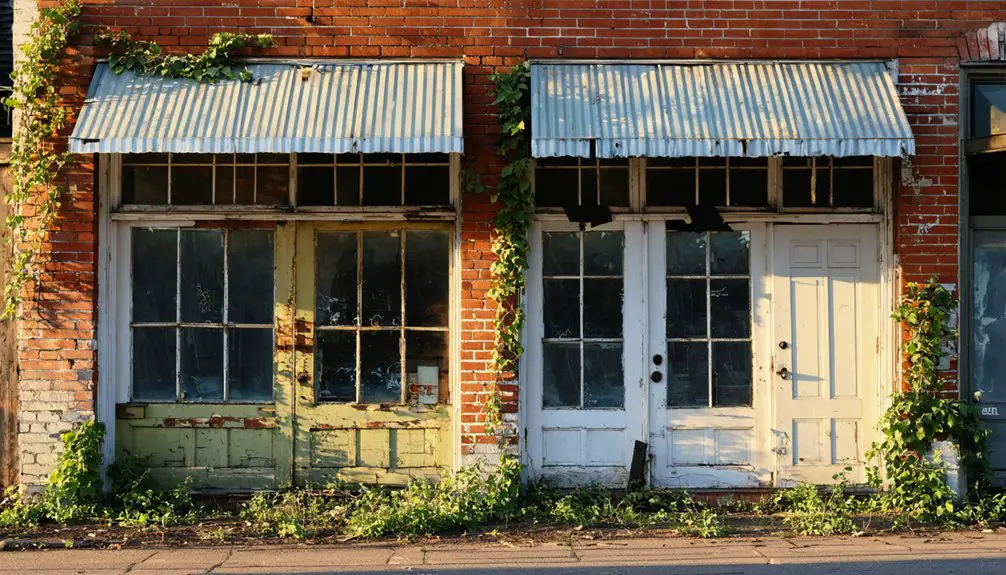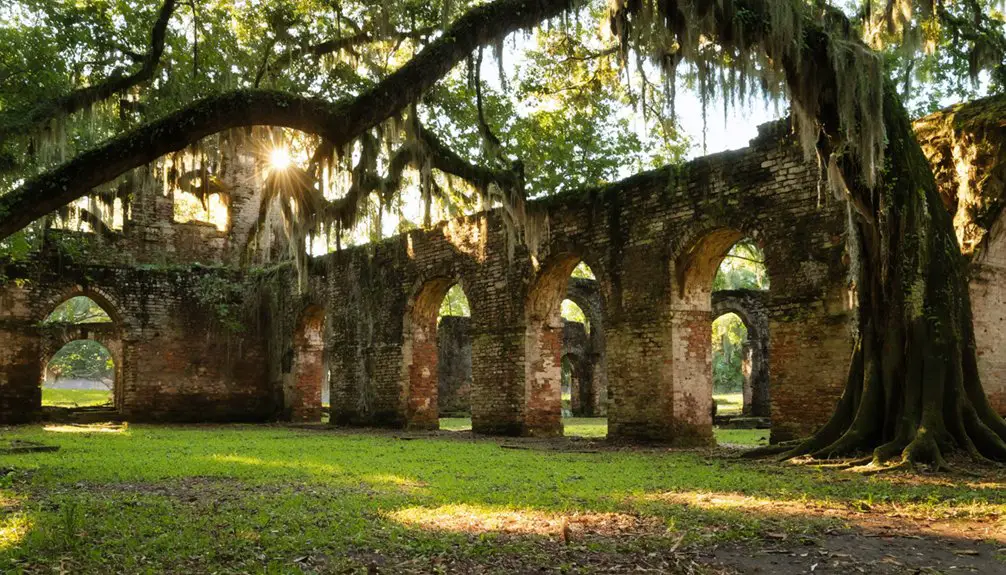You’ll find the submerged remains of Proctor beneath North Carolina’s Fontana Lake, where this once-thriving lumber town flourished until the 1940s. When W.M. Ritter Lumber Company arrived in 1909, the settlement grew from a modest farming community into a bustling industrial hub with 1,000 residents. Today, you can access the underwater ruins by boat or challenging hike, while nearby hilltop cemeteries and local legends tell haunting tales of this vanished community.
Key Takeaways
- Proctor was a thriving lumber town in North Carolina that now lies submerged beneath 80 feet of Fontana Lake’s waters.
- The town peaked at 1,000 residents during W.M. Ritter Lumber Company’s operations before being abandoned for dam construction in the 1940s.
- Underwater ruins can only be accessed by boat or challenging hiking trails through dense forest and difficult terrain.
- Nearly thirty cemeteries remain above water as the last physical remnants of the former community.
- The unfinished “Road to Nowhere” stands as a testament to broken government promises to provide access to displaced residents.
The Rise of a Lumber Empire

Though Proctor began as a modest farming settlement in 1886, it quickly transformed into a bustling lumber town after W.M. Ritter Lumber Company arrived in 1909. You would’ve witnessed the town’s explosive growth as the population swelled to 1,000 residents, drawn by the economic impact of the new sawmill operations.
When public railroads wouldn’t build the necessary lines, Ritter took matters into their own hands, constructing essential rail infrastructure to transport timber products.
The lumber industry’s presence brought unprecedented prosperity to this corner of Swain County. You’d have found a thriving community complete with a train depot, medical services, schools, entertainment venues, and various shops.
Ritter’s innovative approach to large-scale timber operations positioned Proctor as a significant hub in western North Carolina’s industrial landscape.
From Bustling Town to Underwater Legacy
While Proctor thrived as a lumber town through the early 1900s, its fate changed dramatically in the 1940s when the construction of Fontana Dam submerged the community beneath 80 feet of water.
The town’s history took a dark turn as approximately 1,200 families were forced to abandon their homes and ancestral lands to make way for the wartime hydroelectric project.
Today, you’ll find Proctor’s underwater ruins accessible only by boat or challenging hike through the Great Smoky Mountains National Park.
While the Calhoun House and several hilltop cemeteries remain above water, most of the town lies beneath Fontana Lake.
The government’s promise to build an access road was never fulfilled, leaving only the “Road to Nowhere” as a symbol of broken commitments.
Former residents and their descendants still gather for annual Decoration Days to honor their submerged heritage.
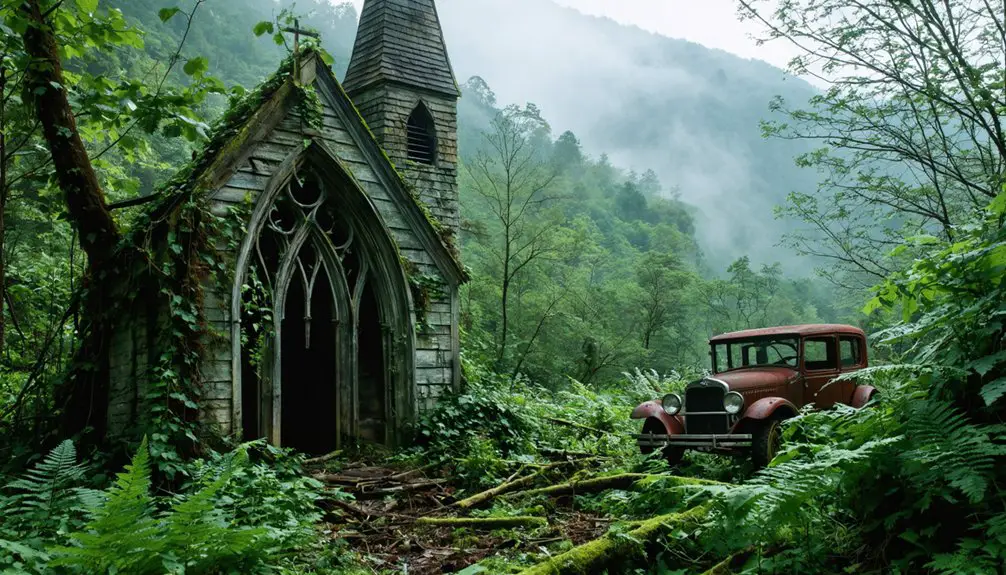
Despite being nestled within the Great Smoky Mountains National Park, reaching Proctor’s ghostly remains presents significant challenges for modern-day explorers.
You’ll need to tackle a 10-mile backcountry trek through dense forest or arrange for a boat ferry across Fontana Lake, as no direct roads lead to this wilderness-claimed settlement.
Proper trail preparation is essential – you’re entering bear and wild boar territory without nearby emergency services.
You’ll want to pack navigation tools, as unmarked paths and weather-worn trails can disorient even experienced hikers.
Beyond the Calhoun House and scattered mill ruins, you’ll discover old foundations and cemeteries slowly returning to nature.
Time your visit carefully, as seasonal flooding and hurricanes can quickly transform these remote paths into treacherous terrain.
Spirits and Legends of Hazel Creek
As shadows lengthen across Hazel Creek’s abandoned landscapes, tales of supernatural encounters have become deeply woven into the area’s cultural fabric.
You’ll hear accounts of ghostly encounters near Proctor’s cemeteries, where the spirits of displaced residents are said to linger among the weathered headstones. The annual Decoration Days event draws descendants who share folklore tales of unexplained phenomena, cold spots, and eerie sounds echoing through the forest.
The infamous “Road to Nowhere” stands as a haunting reminder of broken promises, with visitors reporting strange sensations in its unfinished tunnel.
Near the graves of Moses and Patience Proctor, you might experience the otherworldly presence of those who refused to abandon their beloved community, even after death claimed them.
Preserving Memory Through Sacred Ground
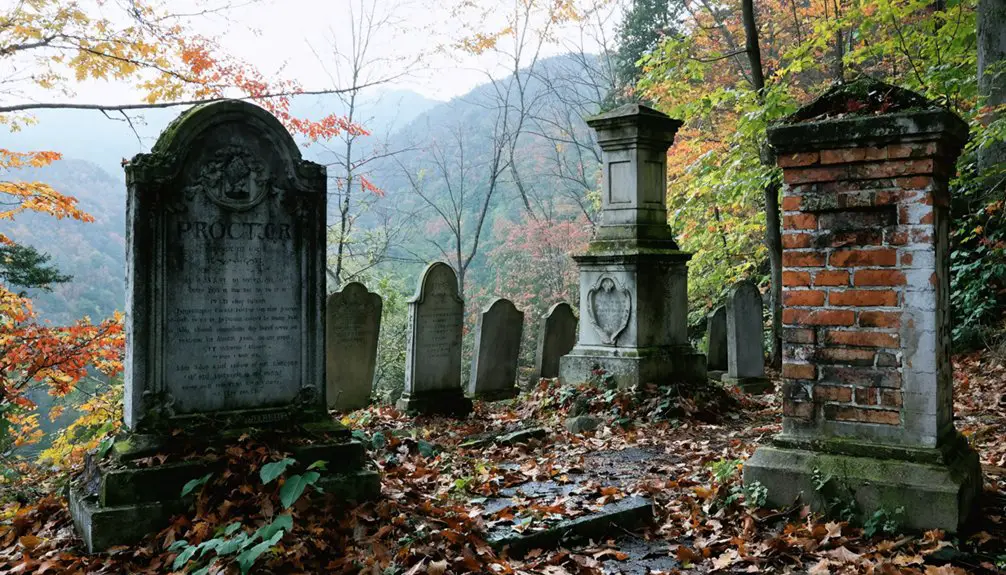
Nearly thirty cemeteries scattered across the Hazel Creek area stand as the last physical memorial to Proctor’s vanished community.
You’ll find over 1,000 graves preserved above Fontana Lake’s waterline, including the marked plots of Moses and Patience Proctor, the town’s first European settlers.
While the dam’s construction submerged homes and displaced 1,200 families, these sacred grounds endure as tangible links to your ancestors.
Through annual Decoration Days, you can join others in grave restoration and community remembrance, though access requires either a strenuous 10-mile hike or boat transport.
The unfinished “Road to Nowhere” stands as a reminder of broken government promises, yet dedicated volunteers continue dowsing for lost graves and placing new headstones, ensuring Proctor’s heritage survives despite its physical absence.
Frequently Asked Questions
Are Any Original Structures From Proctor Still Standing Above Water Today?
You’ll find only the Calhoun House still standing fully above water today, though you can spot the Ritter Lumber Mill ruins during low lake levels as you explore Proctor’s history and submerged relics.
Can You Fish in the Waters Where Proctor Once Stood?
Like casting into history itself, you can fish these waters following standard fishing regulations. While observing water safety, you’ll find bass and catfish swimming above Proctor’s submerged remnants.
What Happened to the Displaced Families After the Flooding?
You’ll find many displaced families scattered across North Carolina after flooding, facing isolation and rebuilding challenges. Most had to start fresh, losing their established community networks and struggling with limited cemetery access.
Is Camping Allowed Near the Old Proctor Town Site?
Like a hidden oasis in the wilderness, you’ll find primitive camping allowed near Proctor, but only at designated backcountry campsites. You’ll need reservations through the Great Smoky Mountains National Park’s system.
Do Any Former Residents or Their Descendants Still Live Nearby?
Yes, you’ll find former residents and their descendants living in nearby communities around Fontana Lake and Bryson City, though they can’t easily access their ancestral hometown due to the lake’s isolation.
References
- https://www.youtube.com/watch?v=F6L7VIBxtXY
- https://www.atlasobscura.com/places/proctor-lost-ghost-town-hazel-creek
- https://blindpigandtheacorn.com/proctor-nc/
- https://wlos.com/news/local/north-carolina-fontana-lake-proctor-town-submerged-underwater-history-100-years-ancestors-families-shorelines-world-war-2-lee-woods-historian
- https://www.lilblueboo.com/2014/07/the-ghost-towns-of-hazel-creek.html
- https://southernappalachiandigitalcollections.org/browse/search/proctor-n-c
- https://npshistory.com/publications/usfs/region/8/history/chap1.htm
- https://historictoxaway.org/logging-1900-1920/
- https://www.slideshare.net/slideshow/proctor-nc-slideshow/12992751
- https://newschannel9.com/sports/outdoors/hazel-creek-you-cant-get-there-from-here
